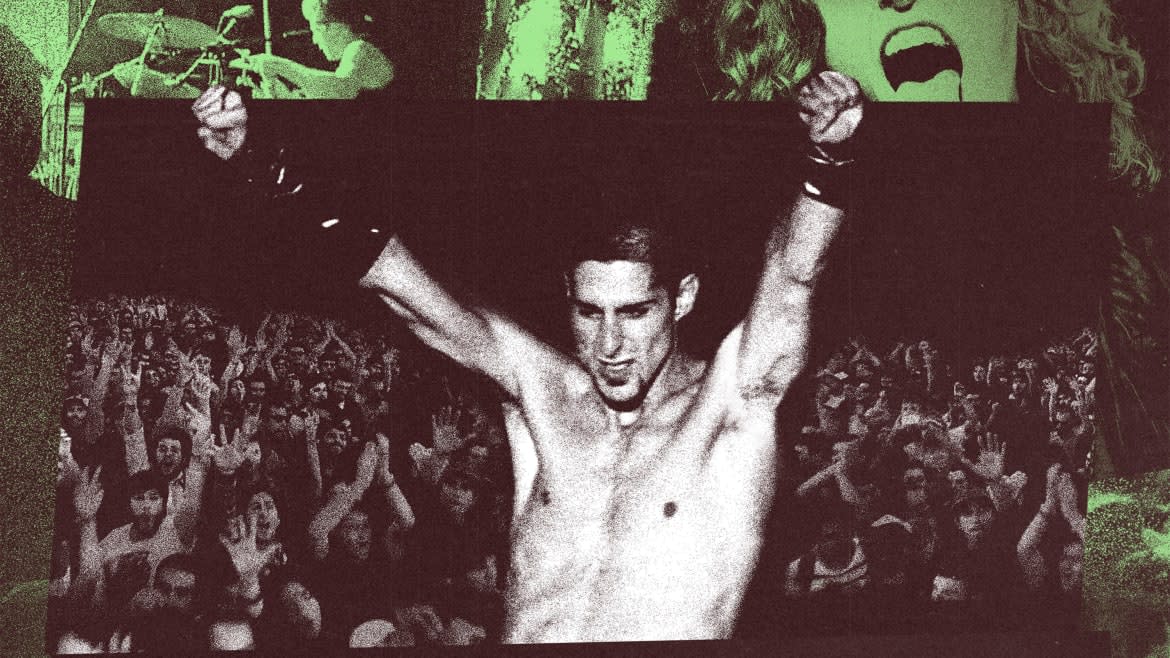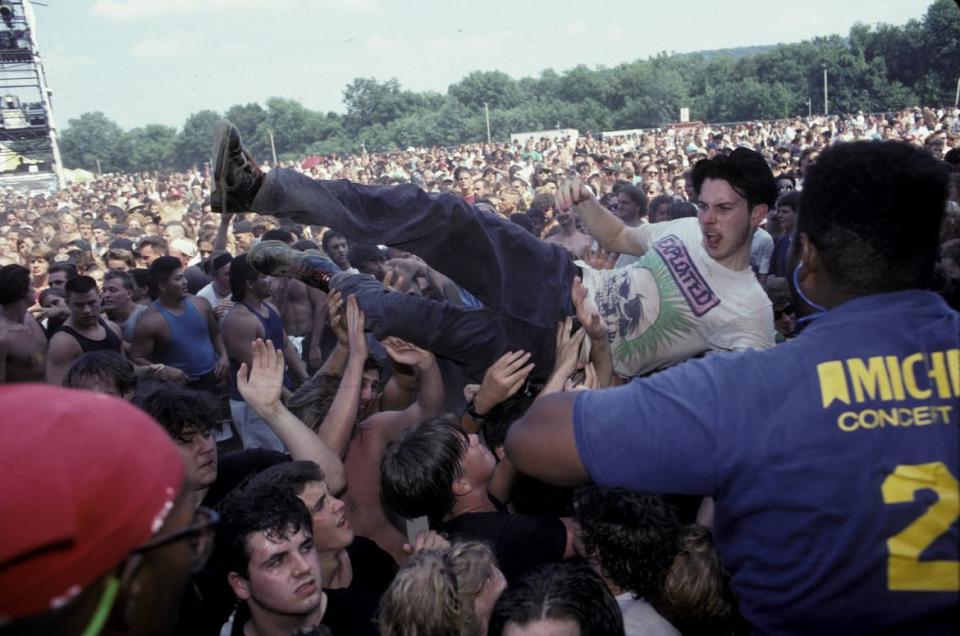How Lollapalooza Became the One Thing Its Founders Hated

During its trailblazing heyday, Lollapalooza provided an unparalleled platform for the alternative. The problem was that by doing so it made the alternative mainstream, which ultimately caused the summer music festival to betray its roots—an inevitable evolution that stands as the most fascinating aspect of Lolla: The Story of Lollapalooza, a nostalgia-fest which understands that all good underground things must either die or become the very thing against which they rebel.
Ironically, Michael John Warren’s three-part Paramount+ docuseries (May 21) is somewhat undercut by a similar dynamic, given that its own desire to end on a happy note means that it must ignore the fact that there’s no going home again to recapture the magic that made a sensation truly sensational in the first place. As a result, it’s ultimately more promotion than critique.
Lollapalooza launched in 1991 as the brainchild of Perry Farrell, frontman for the paradigm-shifting band Jane’s Addiction, who—along with cofounders Ted Gardner, Don Muller, and Marc Geiger—viewed it a way to channel the spirit of England’s Reading Festival (and its ilk) by bringing together an assorted line-up of artists on a single stage. Designed as a farewell for Jane’s Addiction, which planned to disband once this run of shows was completed, it quickly blossomed into an invigorating new take on an old format. Attendees were offered not just one great performance after another, but a common area filled with local avant-garde artists, social activist booths that sought to raise awareness about guns, the environment, and voting, and additional attractions that made it an immersive day-long experience directly attuned to the era’s youth culture.
Just as Jane’s Addiction was at the vanguard of the burgeoning alternative rock movement, Lollapalooza arrived at an auspicious moment, with a variety of bands in different genres offering an antidote to 1980s corporate rock. On its maiden outing, Lollapalooza featured Jane’s Addiction and a collection of acts that suggested a new way forward for rock, from the industrial aggression of Nine Inch Nails and the politicized metal of Ice-T & Body Count to the post-punk experimentation of Siouxsie and the Banshees. To a greater degree than anyone expected, it was a massive hit, thereby spawning subsequent summer iterations that made Lollapalooza a household name and its template the one to emulate. More importantly, it helped launch the careers of many of the decade’s biggest bands, be it Pearl Jam (1992), Soundgarden (1992), Tool (1992/1993), Alice in Chains (1993), Rage Against the Machine (1993), or Green Day (1994), all of whom got big breaks on the Lolla stage.
In the early ’90s, Lollapalooza so perfectly predicted, embraced, and exploited a burgeoning shift that it became an essential part of the teen zeitgeist, and its expansion—including a third stage and myriad ancillary entertainments like the stomach-churning Jim Rose Circus—made it the must-see event of each summer. As Lolla: The Story of Lollapalooza shrewdly points out, a considerable component of that appeal was its diversity. While most attendees may have been white men, the tour’s inclusion of Black and female artists turned it into a melting pot of genres, traditions, and viewpoints. Commentary here from Ice-T, Tom Morello, and Living Colour’s Vernon Reid (among others) helps underscore how thrilling it was to be in an open-minded environment where disparate people and styles found easygoing common ground.
The Sleazy Rise and Humiliating Fall of Ashley Madison
Lolla: The Story of Lollapalooza is led by interviews with Farrell, Muller, Geiger, and their dedicated colleagues, along with musicians who participated in one of Lollapalooza’s multiple go-rounds. Moreover, it boasts considerable archival footage of performances and backstage shenanigans, some of it courtesy of MTV News, which routinely covered the event. In terms of capturing the feel of the era, Warren’s docuseries is spot-on, and that also goes for its examination of the growing pains that accompanied the tour beginning in 1994, when sales were so robust that many began questioning whether the festival had become a showcase for the status quo it originally opposed. Of course, that’s precisely what had happened, although through no fault of its own; like the artists it spotlighted, Lollapalooza was simply a victim of an industry in which alternative bands had unwittingly become the new arena rock gods.

Fans crowd surfing at the Lollapalooza concert in Waterloo Village, New Jersey Aug. 14, 1991.
Lollapalooza’s subsequent attempts to pivot—first back to its indie origins in 1995, and then to aggro stadium metal in 1996—proved equally clumsy. As with 1996’s headliners Metallica, the definition of a modern anti-mainstream band that had transformed into an unstoppable rock goliath, Lollapalooza grew so large that it wound up getting caught in a no-win situation, and following its 1997 iteration, it opted to shut down. Except, as Lolla: The Story of Lollapalooza details in its final installment, it was eventually revived in 2005 as a one-day event in Chicago’s Grant Park. That reinvention was a success, and the docuseries (and Farrell) do their best to paint this as the third act of a heartening story about the beauty of bringing people together to dance, sing, and listen to the music that they love.
Yet while accurate, the redemption-story platitudes forwarded by Lolla: The Story of Lollapalooza about the festival’s Chicago phase—which was marked by memorable performances by Metallica, Rage Against the Machine, Miley Cyrus, Lady Gaga, and various pop stars—can’t overshadow the impression that the original vibe and vitality of Lollapalooza is now a distant memory. Lollapalooza rose from the dead as something mainstream, corporate, and indistinct from the myriad other music events that dot the summer calendar. If Farrell and company are happy with it being a popular regional event for fans of Dua Lipa, Chance the Rapper, and their top-40 compatriots—not to mention an extravaganza that can be duplicated in foreign territories—that’s all well and good. Yet in light of this series’ early celebration of the festival as a crucial landmark in alternative culture, the concluding praise for Lollapalooza’s later incarnations comes across as less a recognition that things change than the type of sell-out that Farrell claims is what he’s struggled against for his entire career.
Get the Daily Beast's biggest scoops and scandals delivered right to your inbox. Sign up now.
Stay informed and gain unlimited access to the Daily Beast's unmatched reporting. Subscribe now.

 Yahoo News
Yahoo News 
